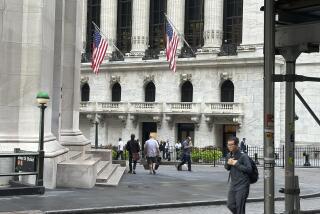Recovery story still plays on Wall St.
- Share via
Millions of Americans will no doubt see the government’s grim report on September employment as confirmation that the “economic recovery” is a mirage.
But Wall Street, which knows a thing or two about how to panic, is refusing to hit that button. In stock prices, at least, the dream of a sustained economic rebound remains very much alive.
The market finished just modestly lower on Friday despite employment data that exceeded nearly everyone’s worst expectations: The economy lost a net 263,000 jobs last month, far above analysts’ consensus estimate of 175,000.
As my colleagues Don Lee and Tiffany Hsu detail in their front-page story today, it was hard to find even a shred of good news in the report.
More troubling, the tally of job losses was just the latest in a string of data over the last 10 days that have flashed caution lights about the economy’s trend, after months of mostly encouraging signs.
Durable goods orders fell more than expected in August. Reports on consumer confidence in September were mixed. And manufacturing activity last month weakened.
The manufacturing data, and nervousness ahead of the jobs report, did finally shake up some investors Thursday, sending the Dow Jones industrial average down 203 points, or 2.1%, to 9,509.28 -- the biggest slide in three months.
But on Friday the Dow quickly recovered from a 78-point drop to end down just 21.61 points, or 0.2%, at 9,487.67.
Measured from the market’s third-quarter peak reached on Sept. 22, most stock indexes have lost between 3.5% and 6.5% -- which is to say, not much. It may be just the start of a more serious pullback, but so far many big-money players clearly are reluctant to bail out of stocks.
After seven straight months of gains that have lifted key indexes 50% or more from their March lows, you’d think there would be a lot more itchy trigger fingers out there.
In fact, a growing number of small investors have been cashing out, as measured by the money exiting domestic stock mutual funds. The funds have suffered net cash outflows every week since mid-August, even as share prices continued to climb for most of that period.
As I wrote a week ago, many individual investors have been leaving stocks in favor of bonds. The appetite for fixed-income securities has been so strong that bond mutual funds have been setting records for net cash inflows.
And this week, some of the big-money players also caught bond fever: The same concerns about the economy that drove stocks down on Thursday also powered a rush into long-term Treasury bonds, driving yields sharply lower.
The 30-year T-bond yield plunged to a five-month low of 3.96%. It inched back up to 4% on Friday, but still is well below its mid-June peak of 4.76% -- even as Uncle Sam has flooded the market with new bonds to finance the budget deficit.
Investors typically run to bonds when they’re looking for relative safety. As doubts about the recovery have increased, some investors have stopped worrying about the possibility that a rebounding economy could spark inflation. They’re now more concerned that renewed weakness could fuel a deflationary spiral of falling prices, falling wages and diving corporate earnings.
The lousy employment data can feed that sentiment, because if consumer incomes remain under pressure there will be little hope for the consumption needed to stoke a meaningful economic revival.
Veteran Wall Street economist David Rosenberg, who was warning well before last year’s meltdown that the debt-laden economy faced extreme risks, believes that deflation already has arrived, even if it isn’t apparent yet in classic inflation gauges.
“We are in a deflationary state. The question is how long it’s going to last,” said Rosenberg, chief strategist at investment firm Gluskin Sheff & Associates in Toronto.
Yet his still is a minority view -- which is evident from how well stocks are holding up.
To the big money managers who push around the mega-dollars, “The risk of not participating in the [market] rally is probably greater than the risk of giving up some of the gains already achieved,” said Jason Trennert, chief investment strategist at Strategas Research Partners, an advisor to institutional investors.
Many remain reluctant to sell stocks, he said, because “there is a big fear of missing out” if the economy keeps improving and shares keep rising.
There also is a fundamental reason why portfolio managers are holding on: They know that, historically, the labor market has been the last thing to recover from recession. And though some of the other economic reports have been weaker than expected lately, they haven’t fallen off a cliff.
Finally, investors are hoping for the same kind of upbeat surprises in third-quarter earnings reports that they saw in second-quarter reports. Most companies’ third-quarter results will be way down from a year ago, but it’s the trend that’s important: If companies show progress, and predict better results ahead, that may be enough for market bulls.
Of course, how the bottom line gets better matters too. Boosting profit by cutting costs -- and in particular, by cutting workers -- can keep investors interested for a while.
But you can’t sustain an economic recovery that way. Even Wall Street is smart enough to figure that out.
--
More to Read
Inside the business of entertainment
The Wide Shot brings you news, analysis and insights on everything from streaming wars to production — and what it all means for the future.
You may occasionally receive promotional content from the Los Angeles Times.










